Day Sales Outstanding (DSO) has become the universal measure of AR health. Walk into any finance meeting, and it's the first metric discussed. Controllers track it monthly. CFOs report it to boards. Analysts use it to compare companies across industries.
The obsession makes sense. DSO is clean, comparable, and board-friendly. It reduces the messy complexity of accounts receivable into a single number that everyone can understand. CFOs love it because it's easy to explain. Controllers love it because it's easy to track with modern accounts receivable automation.
But DSO is measuring the wrong thing. And that tunnel vision is creating blind spots that hurt both cash flow and customer relationships in ways that only become obvious when it's too late.
How DSO became Finance's golden calf
DSO became the North Star sometime in the late 1990s when ERP systems made it easy to calculate and Wall Street analysts started using it to compare companies. Finance teams learned to worship at the altar of days sales outstanding. Reduce DSO, improve cash flow, get promoted.
The logic seemed bulletproof. Faster collections mean better cash flow. Better cash flow means lower borrowing costs, higher returns, more strategic flexibility. Shareholders love companies that convert sales to cash quickly.
Something happened on the way to DSO optimization, though. Companies started optimizing themselves into problems they didn't see coming.
💡 CASE STUDY CALLOUT
A mid-market manufacturing company implemented aggressive collection tactics to reduce DSO from 65 to 42 days. Their AR team celebrated. The CFO presented the improvement to the board.
Six months later, they lost their largest customer—worth $18M annually. While the customer cited pricing pressures as the primary reason, the account manager later learned that billing disputes and collection call frequency had strained the relationship with their AP team.
The customer had been paying consistently on day 47 for three years. Never missed a payment. Never disputed an invoice. But the new collection protocols treated day 47 the same as day 77, creating friction that made the pricing discussions more difficult.
Net result: DSO of 42 days on $18M less revenue.
The averaging problem nobody talks about
DSO has a math problem. It's an average. And averages lie.
A company with 100 customers paying exactly on day 45 has the same DSO as a company where 50 customers pay on day 15 and 50 customers pay on day 75. Same number. Completely different realities.
⚠️ THE AVERAGING TRAP
Company A: 100 customers paying exactly on day 45 = 45-day DSO
Company B: 50 customers paying on day 15 + 50 customers paying on day 75 = 45-day DSO
Same number. Completely different realities.
Company B has 2x the volatility, 2x the collection effort, and likely 2x the customer relationship problems.
Company B has twice as much volatility, twice as much collection effort, and probably twice as many customer relationship problems. But the DSO metric makes them look identical.
DSO treats all receivables as equivalent. The $500K invoice from your best customer that always pays exactly on day 47? Same as the $500K from the customer who's been dodging calls for three weeks. Both contribute equally to your DSO calculation. Both look identical on the aging report.
Your DSO could be improving while your business is deteriorating.
Sophisticated AR teams started tracking Collection Effectiveness Index (CEI) instead of—or alongside—DSO for exactly this reason.
📊 METRIC SPOTLIGHT: Collection Effectiveness Index (CEI)
Formula: (Starting AR + Credit Sales - Ending AR) ÷ (Starting AR + Credit Sales - Ending Current AR)
What it reveals: How effectively you're collecting from receivables that are actually due for payment
Example: 50-day DSO + 95% CEI = excellent effectiveness despite longer terms Vs. 35-day DSO + 82% CEI = speed at the cost of leaving collectible money behind
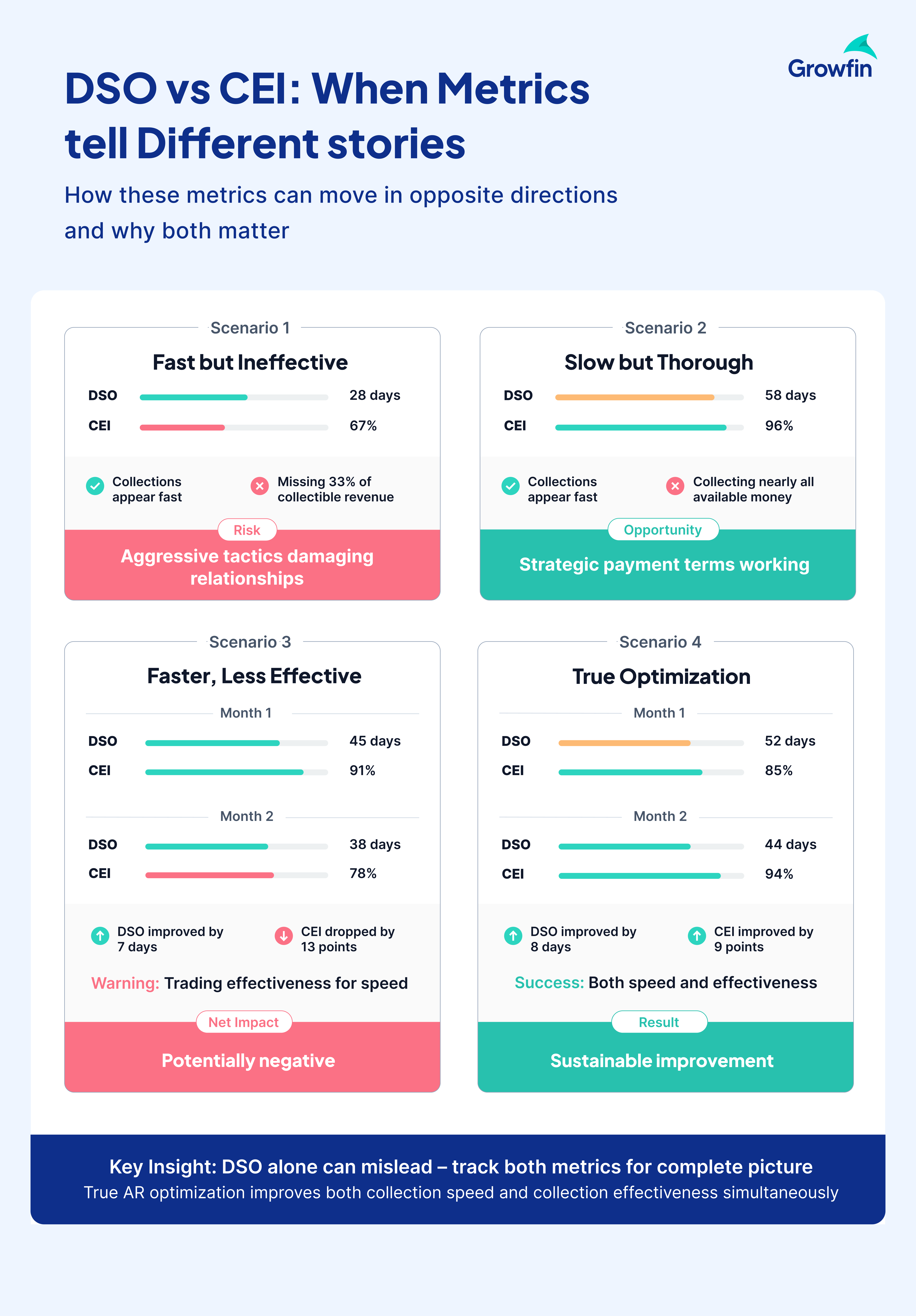
When fast becomes counterproductive
The pressure to reduce DSO creates perverse incentives that nobody talks about in finance meetings.
AR teams start treating all overdue invoices the same. The systematic customer who pays on day 32 gets the same aggressive follow-up sequence as the problem account that might never pay.
This is exactly backwards. The customer paying on day 32 might have a 95% Promise-to-Pay kept rate and a zero dispute rate. The problem account might have a 60% PTP kept rate and multiple open disputes. But DSO optimization treats them identically because both are "overdue."
🎯 Illustrative Example
A software company discovered their enterprise clients consistently paid in 52 days against 30-day terms, but:
- Never defaulted
- Consistently increased spending year over year
- Had complex approval processes that couldn't be rushed
The aggressive collection tactics designed to improve DSO were creating friction with exactly the customers they couldn't afford to lose.
When they segmented their approach:
- DSO increased slightly
- Cash flow forecasting accuracy: 73% → 91%
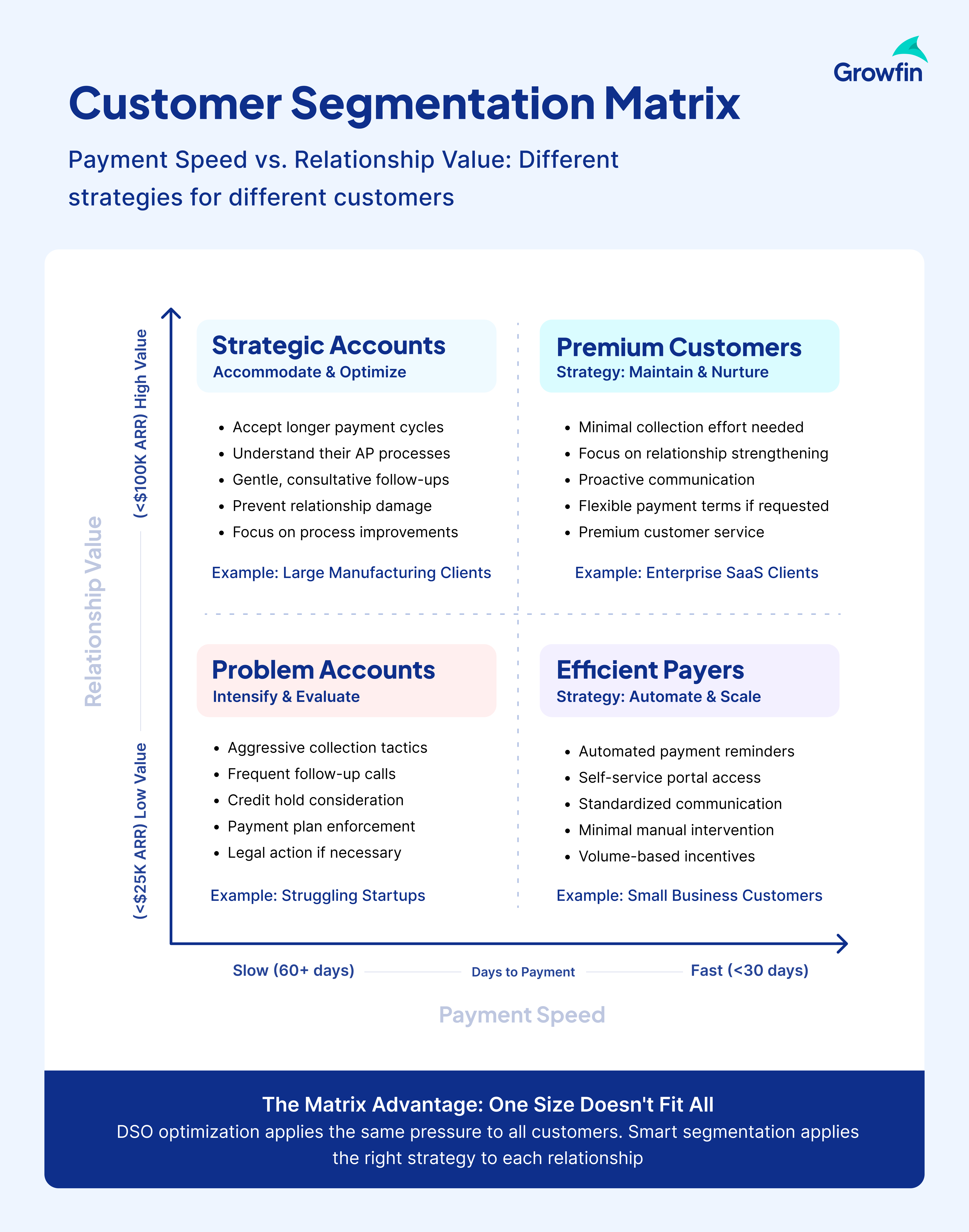
When the software company started tracking Average Days to Pay alongside DSO, they discovered that their enterprise clients' 52-day pattern was actually predictable and sustainable. These customers had complex approval processes that couldn't be rushed without creating internal friction.
Most AR teams discover this the hard way. They focus on bringing down the average and accidentally create more variance in the process. They squeeze the customers who were already paying reasonably well and ignore the ones driving the real problems.
Result: Lower DSO. Higher stress. More customer complaints. More unpredictable cash flow.
The costs hidden in plain sight
The most revealing metrics are usually the ones that DSO can't see.
Dispute Rate can increase due to manual processes, lack of proactive communication, poor documentation, or billing errors—problems that DSO optimization doesn't address. Right Party Contact Rate falls when teams increase call volume without improving targeting. Cost Per Dollar Collected climbs when DSO improvements require unsustainable resource investment.
⚡ HIDDEN COST EXAMPLE
A 5-day DSO reduction that doubles collection costs might hurt more than help overall profitability.
These quality metrics expose the hidden costs of DSO optimization that don't appear in the primary measurement.
Take Dispute Rate—the percentage of invoices that customers formally challenge. Higher dispute rates often stem from manual processes that create errors, lack of proactive communication about payment expectations, or inability to address customer concerns before they escalate. Teams focused solely on DSO miss these underlying process problems that create additional work and relationship strain.
Right Party Contact Rate tells a similar story. Teams might improve DSO by increasing call volume while watching RPC rates decline, indicating more effort for similar results. The DSO improves, but the underlying efficiency degrades.
Beyond speed: what actually drives cash flow
Companies that truly understand cash flow management don't just track collection speed. They track collection intelligence across four critical areas that DSO completely ignores.
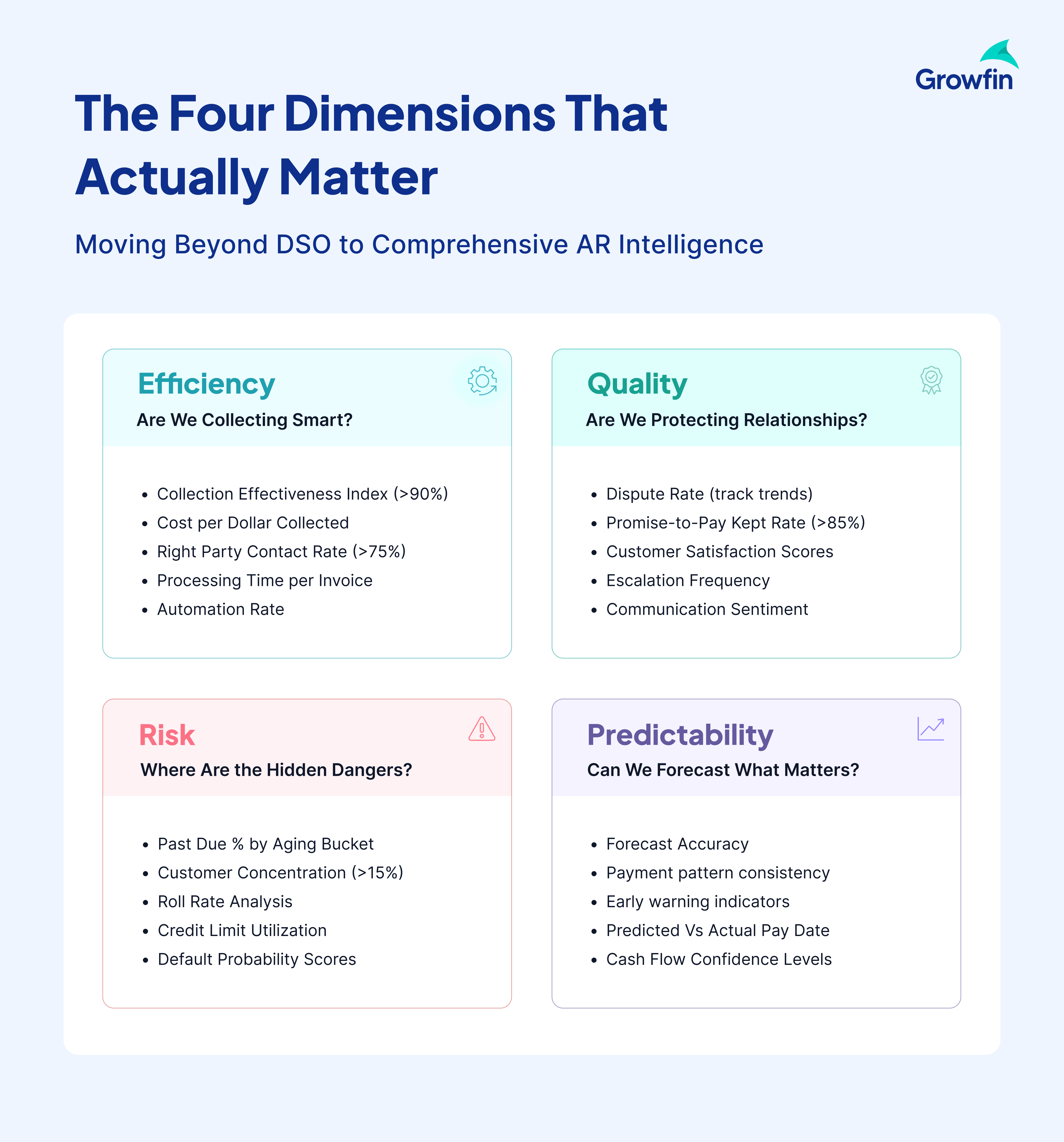
Getting more done with less: Efficiency
The best AR teams measure how effectively they convert effort into results. Collection Effectiveness Index shows how much collectible money they're actually collecting (target: >90%). Cost per Dollar Collected reveals what collection efficiency costs, and whether it's sustainable. Right Party Contact Rate tracks whether they're reaching decision-makers or wasting time on gatekeepers (target: >75%).
One company discovered they were spending 40% more time per collection call but reaching the actual decision-maker only 60% of the time. Their DSO was improving, but their efficiency was cratering.
Protecting what matters most: Relationships
Speed without relationship health is a losing game. Dispute Rate tracking reveals trends more than absolute levels—spikes often indicate process problems rather than customer problems. Promise-to-Pay Kept Rate (target: >85%) shows customer reliability and reveals relationship strength. Customer Satisfaction Scores from payment experience surveys catch problems early, before they show up in other metrics.
A manufacturing company saw their dispute rate spike 30% over six months. Initially, they blamed difficult customers. Deeper analysis revealed their new billing system was generating invoices with formatting errors that confused AP departments.
Spotting danger before it hits: Risk Detection
DSO averages mask concentration and volatility risks that can destroy cash flow overnight. Past Due Percentage by aging bucket helps you understand the distribution, not just the average. Customer Concentration tracking ensures no single customer represents >15% of AR. Roll Rate Analysis tracks how receivables move between aging buckets—it's an early warning system for systematic problems.
One SaaS company looked healthy with a 38-day DSO until they realized 60% of their AR was concentrated in three customers who were all showing early signs of financial stress.
Predicting what's coming next: Forecasting
The companies that get cash flow right focus on prediction accuracy over historical reporting. Forecast Accuracy measures how well predicted collections match reality. Payment Pattern Consistency by customer segment recognizes that reliable trumps fast. Early Warning Indicator Tracking identifies behavioral signals that predict problems before aging reports show them.
Predicted vs Actual Pay Date analysis became a game-changer for one logistics company. They discovered their "slow-paying" customers were actually highly predictable—they just had longer cycles. The "fast-paying" customers were actually more volatile and harder to forecast.
Why the best companies accept "worse" DSOs
Companies that understand this build AR measurement systems around customer behavior patterns rather than arbitrary targets.
Their DSO might not be the lowest in their industry. But their cash flows are more reliable, their customer relationships are stronger, and their finance teams focus on strategic activities instead of chasing metrics that don't drive sustainable performance.
Leading finance teams track Best Possible DSO (BPDSO) alongside current DSO. BPDSO calculates what your DSO would be if you collected all current receivables immediately. The gap between DSO and BPDSO reveals how much improvement is theoretically possible.
📈 METRIC SPOTLIGHT: Best Possible DSO (BPDSO)
Formula: Current AR ÷ Daily Sales
What it reveals: What your DSO would be if you collected all current receivables immediately
The gap between DSO and BPDSO reveals improvement potential:
- DSO 45 days + BPDSO 44 days = minimal improvement possible
- DSO 45 days + BPDSO 32 days = significant opportunity without customer alienation
They've learned that sustainable cash flow beats fast cash flow. That predictable beats optimal. That customer relationships drive long-term performance in ways that pure collection speed cannot.
The real goal: smarter collections
The goal isn't faster collections—it's smarter collections.
Collections that:
✅ Strengthen customer relationships while optimizing cash flow
✅ Provide predictability that enables better planning
✅ Sustain long-term growth requirements
✅ Guide strategic decisions beyond transaction processing
The ultimate objective isn't just lower DSO—it's predictable, sustainable cash flow with minimal customer friction and optimal resource allocation.
Sometimes that means accepting longer payment terms from valuable customers who pay reliably. Sometimes it means investing more collection effort in smaller accounts with higher variance. Sometimes it means building customer-specific strategies that acknowledge different payment realities.
DSO can't guide these decisions because it treats all payment timing equally. But payment timing isn't equal. Context matters. Relationships matter. Predictability matters.
The solution isn't abandoning DSO. It's understanding its limitations and building measurement systems that provide the intelligence needed to optimize cash flow without sacrificing growth.
That means tracking collection effectiveness alongside collection speed. Measuring customer relationship health alongside payment timing. Monitoring predictability alongside efficiency.
The goal isn't faster collections—it's smarter collections. Collections that strengthen customer relationships while optimizing cash flow. Collections that provide the predictability that enables strategic planning and the sustainability that long-term growth requires.
The question isn't whether your DSO is good or bad. The question is whether you can predict next Tuesday's bank deposits with confidence—and whether your collection process strengthens or strains the relationships that drive long-term success.
DSO will always be on your dashboard. But it shouldn't be the only thing driving decisions.
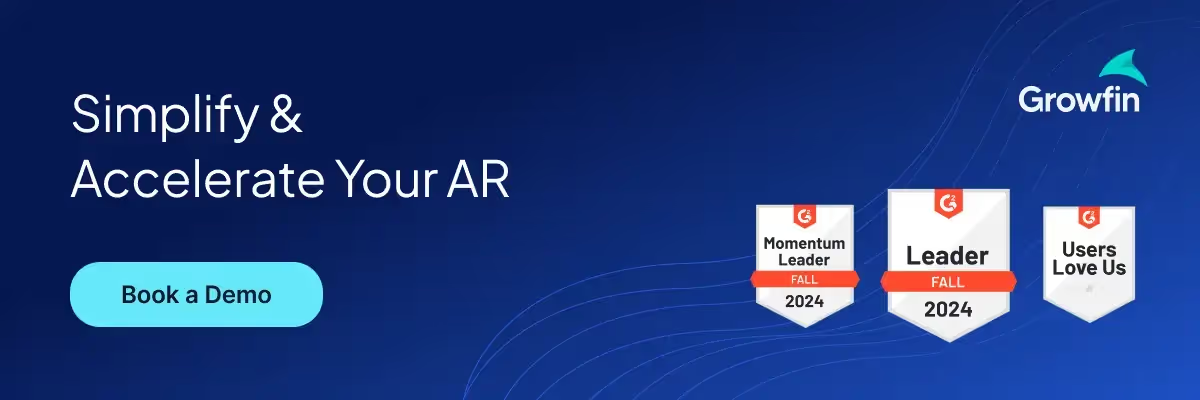


.png)
.webp)


.webp)













.webp)




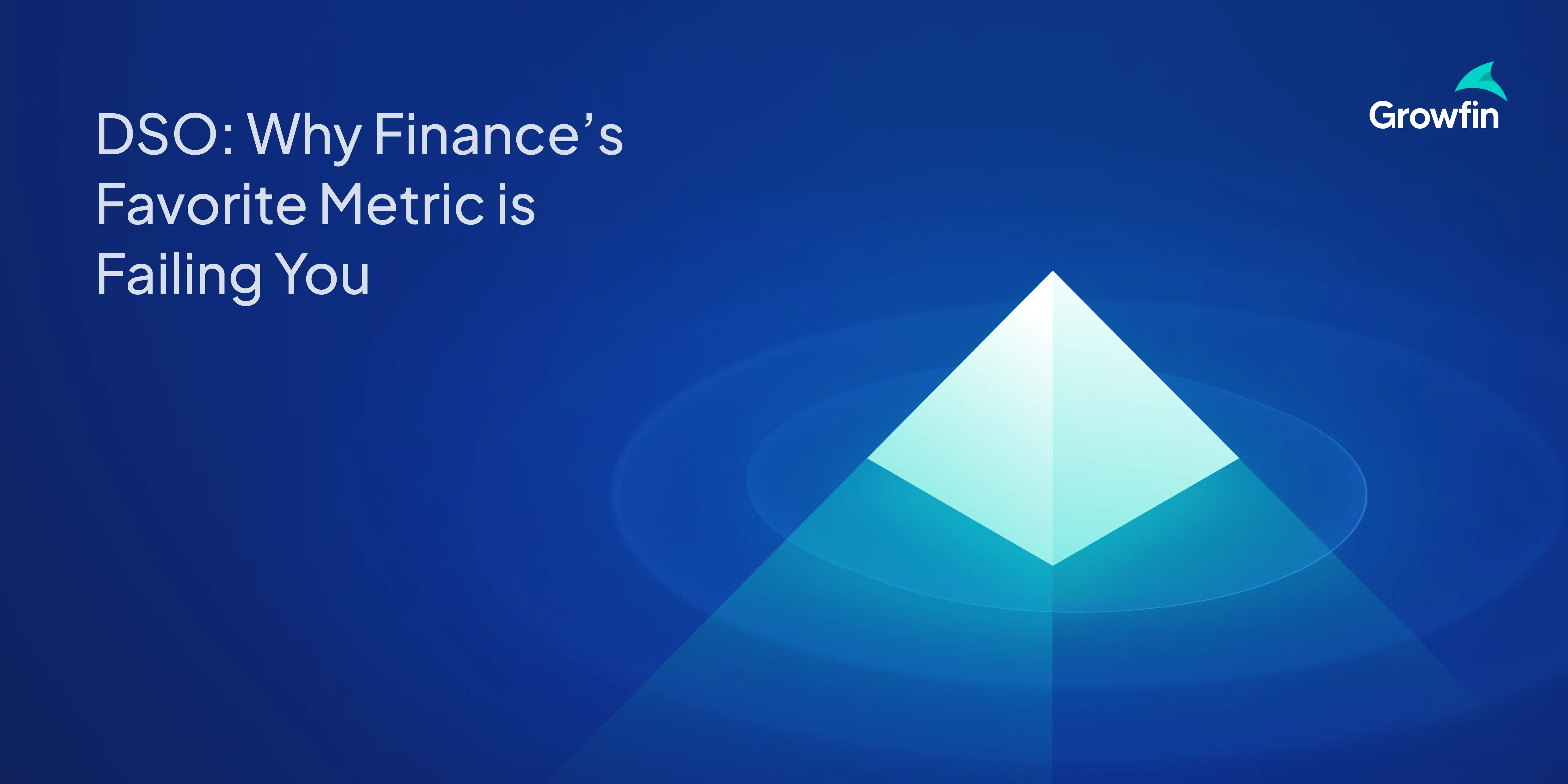


.webp)
.webp)
.webp)
.webp)